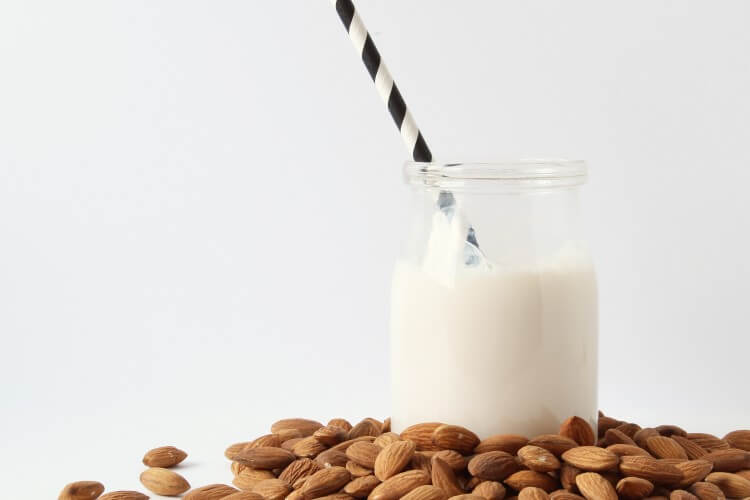Are you trying to decide whether or not you want to give almond milk a try, curious about the way it tastes?
Almond milk has a mild, nutty flavor. However, the flavor can vary depending on whether or not it’s sweetened, flavored, and ingredients used in it.
The taste of almond milk can also change based on how you’re using it (e.g. cereal, coffee, and tea).
Read on to learn more about what almond milk tastes like and it’ll please your palette.
What Does Almond Milk Taste Like?
Different brands of almond milk have different flavor palettes. This is because each brand uses different recipes and production processes to make its milk unique.
All almond milk includes almonds and water. The simplest almond milk recipes cover these basic steps:
Soak the almonds in water overnight
Drain the soaking water
Rinse the almonds
Blend softened almonds and new water in a food processor
Strain the almond milk through a cheesecloth bag or fine strainer
Discard almond pulp
Yet, most brands have more complex recipes than that.
They may use salt or other preservatives, flavored ingredients like maple syrup, dates, or vanilla, and viscosity-altering ingredients like sunflower lectin.
When food writers talk about the flavor of milk, they typically use two sets of vocabulary words.
The first set of terms tells you about the flavor of the milk. The second set tells you about its texture.

Almond Milk's Flavor
Food writers describe milk using five flavor categories. They overlap with the core flavor categories in the cheese flavor wheel.
The categories are:
- Lactic
- Vegetal
- Microbial (yeasty)
- Core Taste
- Lipid/Torrefaction

Each of these categories can be broken down further. For example, the core taste of milk may be bitter, salty, sweet, acidic, or umami.
Lactic flavors can be cooked, burnt, caramelized, fresh, milky, buttery, or sweet.
Some of the flavor categories can blend to describe a complex flavor experience.
Food critics may bring in terms from beverage tasting. One popular resource is the World Coffee Research Group's sensory lexicon.
For example, if an almond milk recipe uses yeast activation, a thermal process, and it incorporates nutmeg and maple syrup, it might taste something like this:
Almond milk has a nutty, caramelized malt flavor.
The smoky, brown-spiced aroma evokes the idea of whiskey, but it's an idea transfigured by the sweet aftertaste.
But this, in and of itself, doesn't convey the full experience of drinking a specific brand of almond milk.
Almond Milk's Texture
To describe almond milk's texture, let's look at beverage tasters' vocabulary again.
Many of the texture-terms milk tasters use are imported from wine-tasting. Thus, food critics are likely to describe almond milk's texture in terms of "mouthfeel."
Mouthfeel is the physical sensation of milk in your mouth. And, it describes the sensation that remains after you've swallowed the milk.
You can break down the mouthfeel of a specific almond milk product into six categories:
- Body (viscous, thick, thin)
- Astringency (moistening, drying, evaporation)
- Smoothness (silky, velvety, rough, gritty)
- Heaviness (heavy, light, delicate)
- Creaminess (buttery, oily, milky, watery)
- Temperature (warming, cooling)
Outside of these categories, a taster might note if a drink has a bubbly or tingly aftertaste.
Tasters often consider brisk milk particularly refreshing.
Other textures, like a metallic or butyric aftertaste, are less welcome.
Butyric aftertastes are most associated with parmesan cheese or rancid butter.

Does Almond Milk Taste Like Almonds?
If you've never had almond milk before, it makes sense to wonder if it tastes like almonds. It's mostly almonds, right?
Sometimes, but not usually. After you soak almonds, then blend them with even more water, the "almond-y" flavor you associate with eating the nuts has been pretty watered down.
Instead, almond milk typically takes on the flavors of the ingredients used to make it. In the past, companies often tried to create almond milk that mimicked the flavor of dairy milk.
Today, an almond milk's flavor profile often overlaps with wines more than dairy milks. This overlap stems from the presence of tannins. Tannins are molecules naturally found in some grapes, and they create "dry" wine.
They also contribute to buttery wines. Tannin structures contribute to the texture of a beverage.
That said, many companies create almond milk through tannin-free processes.
Does Almond Milk Taste Like Regular Milk?
In blind taste tests, popular food writers named a few almond milk brands as tasting nearly identical to dairy milk:
WholeFoods Organic 365 Everyday Almond Milk
Silk Next Milk
Blue Diamond Almond Milk
That said, some people don't want almond milk that tastes like dairy milk.
The real question is, does almond milk taste good?
Overall, almond milk tends to be a nutty, medium-bodied beverage. It can lean sweet, but it can also lean into savory flavors.
In fact, certain umami sauce recipes call for almond milk.
Blended with reishi mushroom powder and smoked paprika, almond milk can cultivate a creamy, Asian-inspired sauce.
What Does Unsweetened Almond Milk Taste Like?
The flavor of unsweetened almond milk varies by brand. But, it often has a velvety texture.
Most brands of unsweetened almond milk have a lightly sweet aftertaste.
Most unsweetened almond milk sold in stores lists "natural flavors" among its ingredients.
These flavors may be vegetal, like peapod, which contribute to a "fresh" taste. Or, they may be blends of powdered fruit, flowers, or spices.
These "natural ingredient" mixtures are often proprietary. Brands keep their exact compositions guarded.
We generally recommend avoiding "Natural flavors" when possible. Learn more about natural flavors here.
That said, when a brand labels its almond milk as "unsweetened," they try to maintain a balance among the natural flavors in the blend. If one flavor dominates, it won't taste like "plain" milk anymore.
The most basic almond milk is thin and watery—almost tea-like.
But, almond milk manufacturers use different strategies and ingredients to thicken it. Heat is popular.
Heated almond milk is thicker, and it often has a smoky or caramelized flavor element.
If you thicken unsweetened almond milk with yeast, it may cultivate a malted or whey-tainted body. But, you also risk it going poorly: overgrown yeast can turn almond milk sour.
What Does Sweetened Almond Milk Taste Like?
Brands typically incorporate added sugar to sweetened almond milk. Vanilla and maple syrup are also common sweetening ingredients in almond milk recipes.
Sweetened almond milk often tastes like a sweeter version of a brand's unsweetened milk. It's comparable to milk left in the bowl after you eat a frosted cereal.
While brands vary, sweetened almond milk tends to be on the thinner side. It's often fresh or brisk more than creamy or buttery.
Unsweetened almond milk is still smooth, and it still has the aromas and flavors of unsweetened almond milk. The nuttiness and hint of spice or fruit are still there. But it's less likely to be heated (to avoid caramelization).
What Does Vanilla Almond Milk Taste Like?
Vanilla is one of the most popular flavors in almond milk recipes. It acts as a sweetener, and it's similar to brown sugar, molecularly. This lets it add flair to a base that may otherwise be too nutty or blandly malty.
Vanilla gives an almond milk recipe sweetness and richness, even in unsweetened versions. Because it isn't a sugar, vanilla amplifies sweetness without overwhelming.
Brands that offer vanilla almond milk typically add additional vanilla flavoring on top of the vanilla in the original recipe. Think of getting a vanilla flavor shot in a latte.

What Does Almond Milk Taste Like in Coffee?
This is a question where thickness absolutely matters.
Piping hot coffee can heat up almond milk. This catalyzes naturally occurring enzymes in almond milk recipes.
The enzymes (proteins) make almond milk thicker.
As a result, sometimes almond milk tastes full-bodied, velvety, and even smokey or burnt in coffee.
For some, this overwhelms the almond milk's natural nutty, aromatic flavors.
But, other brands make thinner, watery almond milk. And, not all almond milk recipes include those enzymes.
So, a splash of thin almond milk in coffee often tastes smooth, almost dry, and there's a hint of a nutty or sweet aftertaste.
People who love the flavor of their coffee often choose thinner brands of milk. This lets the coffee flavors dominate, while the almond milk offers a light patina of flavor.
Related: Why Does Almond Milk Curdle?
What Does Almond Milk Taste Like in Tea?
The thinnest brands of almond milk, like So Delicious, match the consistency of tea.
For some aficionados, this makes it an ideal addition to the drink. In tea, thin almond milk tastes cool and refreshing.
Its flavors are light enough that they're hard to distinguish from the tea. That said, almond milk tends toward nutty flavors and away from florals, while teas trend in the opposite direction.
Thick almond milk almost absorbs tea. A creamy, heavy almond milk—possibly microwaved—may give off a roasted, even caramelized flavor. Its natural sweetness will be enhanced by the tea.
Ultimately, thick almond milk in tea becomes a rich, nutty, tea-flavored beverage.
Related: Is There Milk in Boba Tea?
What Does Chocolate Almond Milk Taste Like?
Chocolate is a bitter, cocoa-based flavor. Contemporary chocolate flavoring is often sweetened into a molasses-like cream that retains a sliver of the cocoa's bitter edge.
It's hard to pinpoint where chocolate ends and the almond milk sweetener begins. This sweetness gradient makes chocolate almond milk a surprising, creamy treat.
What Does Silk Almond Milk Taste Like?
Silk is a popular, international brand of non-dairy milk. Many food critics praise Silk's "Next Milk" line as tasting almost identical to dairy milk.
The plain, unsweetened Silk almond milk is on the thinner side. It's creamy and smooth, and the nuttiness—while present—is incredibly subtle. It's a popular choice with tea and cereal.
Conclusion
There are more non-dairy milks on the market than ever before. Fortunately, you don't have to wonder, "what does almond milk taste like?" before you buy it.
With Milk Pick, you can learn the ins and outs of every milk on the market. Discover which milk is right for you today with our side-by-side comparisons.
